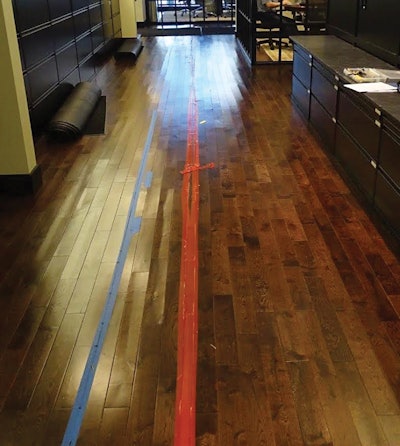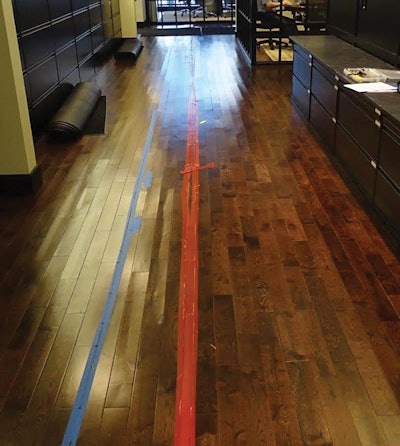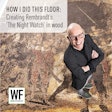

 The concrete substrate of this buckling floor had been raised with over 200 cubic yards of concrete.
The concrete substrate of this buckling floor had been raised with over 200 cubic yards of concrete.

The Issue
The white oak floors in a 42,000-square-foot commercial building were buckling, and a certified wood flooring inspector was called.
Roy: The Inspector's Observations
The wood floors had been glued down over a slab. It was discovered that moisture levels exceeded 21% in the affected areas, which measured approximately 6 feet in width. The moisture levels dissipated to 9% closer to the walls. After a lot of searching for the possible water source, the original blueprints of the building revealed there were eight rooftop drains that came down through the interior columns and went to a center pipe that led to the sewer. I then discovered that, prior to the installation of the wood flooring, the concrete slab had to be mudjacked (raised) with more than 200 cubic yards of concrete. After that, the concrete still required self-leveler up to 3 inches thick in some areas. It seemed probable that mudjacking had damaged the center drainage pipe, and I had the installer confirm that water on the roof was not draining after a rain.
The installer did do substrate testing prior to installation, and the tests showed acceptable moisture levels. I concluded the installer had no indication of what was lurking below the substrate and determined this failure was beyond the installer's control.
Blake: The Attorney's Analysis
It appears there was no way the installer could have known that the mudjacking contractor had possibly damaged a hidden pipe—or whatever ended up causing the moisture issue—and thus the installer would not be responsible if the floor fails. With that said, I would be interested to see the terms of the contract between the parties. Contracts often cover unforeseen site conditions and usually include detailed language about how to properly give notice of a claim and seek additional compensation for hidden problems or delays. In this case, even if the contract did include such language, the property owner and installer apparently could never have known about the problems while doing the work, so it would have been impossible to give notice at the time the floor was installed. However, the parties might be under certain timelines to act now that the issues are known.
If the mudjacking is the issue, the property owner will ultimately need to make a claim against the mudjacking company, which will need to tender the claim to its insurance company. Alternatively, the property owner's insurance company could repair the damages and seek reimbursement from the mudjacking company and its insurer. Regardless, the wood flooring contractor should not be responsible.

































